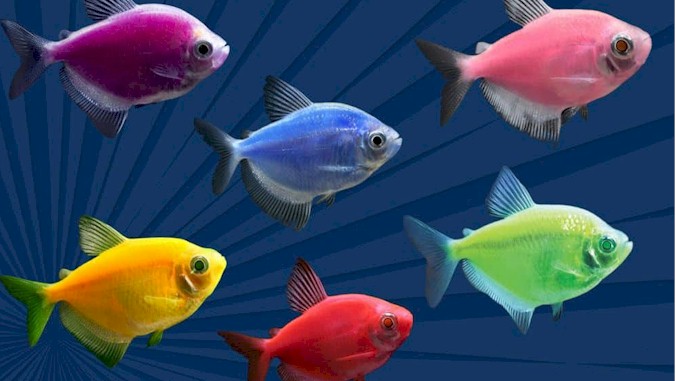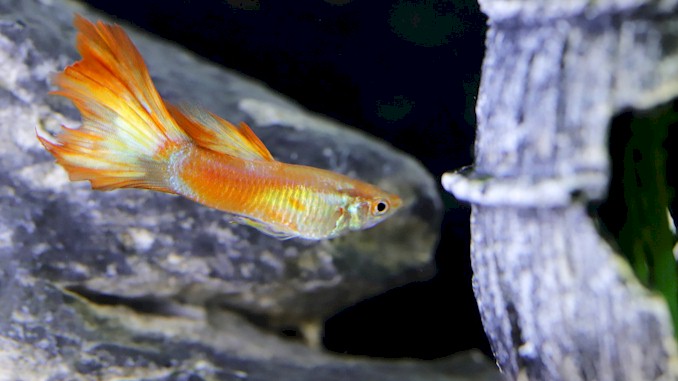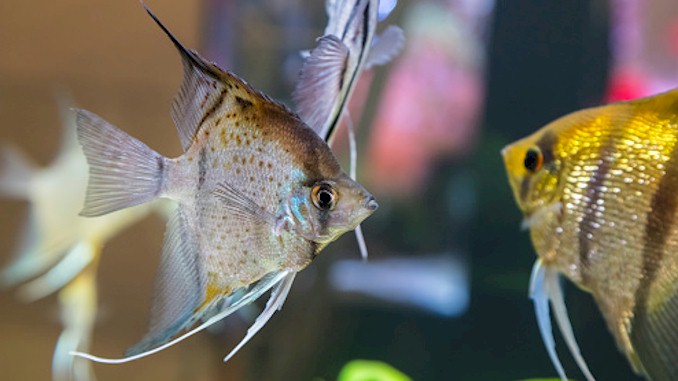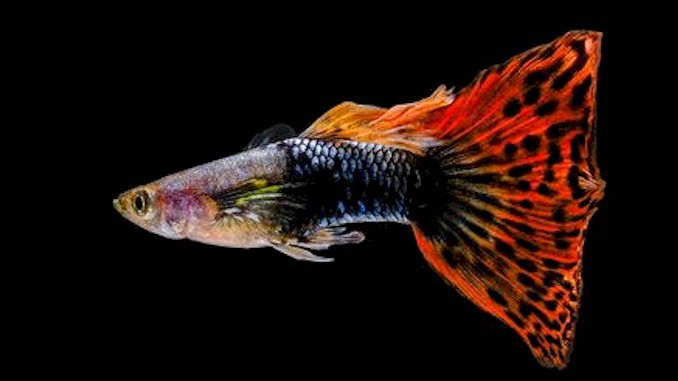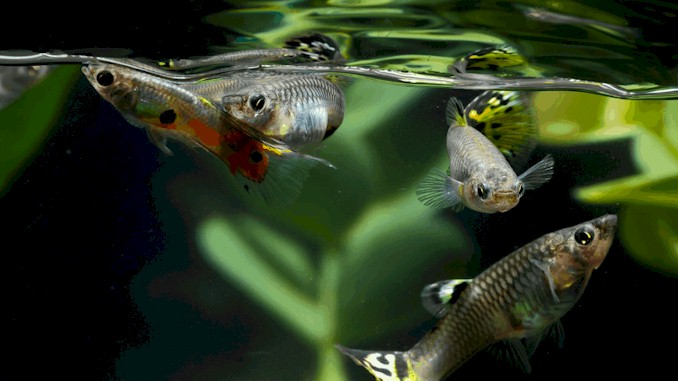Can Guppies Live With Glofish
The sight of GloFish left me awe-struck and filled with curiosity. Their fluorescent, vibrant colors seemed almost unreal, and I couldn’t believe that they were living creatures. As I watched them swim, I wondered if it would be possible to add them to my existing guppy tank, and thus began my journey to explore this topic further. After hours of research and study, I have compiled all my findings and insights in this article. Read on to discover what I have learned about keeping GloFish and guppies together in one tank.
Whether guppies can live with Glofish depends on the type of Glofish. Glofish are genetically modified fish that come in different varieties, such as tetras, danios, barbs and sharks. Guppies are compatible with tetra Glofish and barb Glofish, but not with danio Glofish and shark Glofish. This is because guppies prefer peaceful and non-aggressive tank mates, while danios and sharks can be nippy and territorial.
If you are interested in learning more about keeping guppies and glofish together, I am going to share with you the details about the specifics of tank size, water conditions, and compatibility, as well as provide tips on feeding and caring for these fish. I’ll also address some common concerns and misconceptions about glofish and genetic modification, so you can make an informed decision about whether these fish are right for your aquarium. So, let’s dive in and explore the world of guppies and glofish!
Which Types of Glofish Can Live with Guppies and Why?
Glofish are genetically modified fish that have been injected with fluorescent genes from other organisms, such as jellyfish and coral. They come in different varieties, such as barbs, bettas, danios, tetras and sharks. Each variety has its own characteristics and behaviors that affect their compatibility with guppies.
Guppies are small, colorful and peaceful fish that can live in a wide range of water conditions. They are easy to care for and breed prolifically. They prefer to live in groups of at least six individuals and get along with most non-aggressive fish.
The types of glofish that can live with guppies are:
- Tetra glofish: These are modified versions of black skirt tetras that have a slim body and a forked tail. They come in six colors: starfire red, electric green, sunburst orange, cosmic blue, galactic purple and moonrise pink. They are active and social fish that like to swim in schools of at least five individuals. They can grow up to 2 inches long and need a tank size of at least 10 gallons. They are compatible with guppies because they have similar water requirements (temperature: 72-82°F; pH: 6-7.5) and temperament (peaceful and friendly).
- Barb glofish: These are modified versions of tiger barbs that have a flat body covered in dark tiger-like stripes. They also come in six colors: starfire red, electric green, sunburst orange, cosmic blue, galactic purple and moonrise pink. They are lively and playful fish that like to chase each other around the tank. They can grow up to 3 inches long and need a tank size of at least 20 gallons. They are compatible with guppies because they have similar water requirements (temperature: 74-79°F; pH: 6-7) and temperament (peaceful when kept in large groups).
The types of glofish that cannot live with guppies are:
- Danio glofish: These are modified versions of zebra danios that have a slender body with horizontal stripes. They also come in six colors: starfire red, electric green, sunburst orange, cosmic blue, galactic purple and moonrise pink. They are fast-swimming and energetic fish that like to dart around the tank surface. They can grow up to 2 inches long and need a tank size of at least 10 gallons. They are not compatible with guppies because they have different water requirements (temperature: 64-74°F; pH: 6.5-7) and temperament (nippy and aggressive when kept in small groups)3.
- Shark glofish: These are modified versions of rainbow sharks that have a torpedo-shaped body with a high dorsal fin. They only come in one color: electric green. They are territorial and predatory fish that like to hide under rocks or plants. They can grow up to 6 inches long and need a tank size of at least 50 gallons. They are not compatible with guppies because they have different water requirements (temperature: 75-81°F; pH: 6.8-7.8) 4and temperament (aggressive and will eat smaller fish).
As you can see, not all types of glofish can live with guppies. You need to do some research before you buy any glofish for your aquarium. You also need to consider other factors such as tank size, water quality, diet, and decoration.
How to Choose the Right Tank Size and Shape for Guppies and Glofish?
One of the most important factors that affect the health and happiness of your guppies and glofish is the size and shape of your tank. Choosing the right tank can make a big difference in how well your fish get along, how much space they have to swim, how easy it is to maintain the water quality, and how beautiful your aquarium looks.
Here are some tips on how to choose the right tank size and shape for guppies and glofish:
- Consider the number and type of fish you want to keep: The general rule of thumb for stocking fish is 1 inch of fish per gallon of water. However, this rule can vary depending on the activity level, temperament, and bioload of your fish. For example, glofish are more active than guppies and produce more waste, so they need more space than guppies. Also, some types of glofish are larger than others, such as barbs (3 inches) and sharks (6 inches), so they need bigger tanks than tetras (2 inches) 2. Therefore, you should consider not only the number but also the type of fish you want to keep when choosing a tank size.
- Choose a tank that is long rather than tall: Both guppies and glofish are schooling fish that like to swim horizontally rather than vertically 35. Therefore, they prefer tanks that are long rather than tall. Long tanks provide more surface area for oxygen exchange, more swimming space for your fish, and better visibility for you. A good shape for a guppy-glofish tank is a rectangular or bow-front tank that has a length-to-height ratio of at least 2:1 4.
- Avoid overcrowding your tank: Overcrowding your tank can cause many problems for your guppies and glofish. It can lead to stress, aggression, disease, poor water quality, and stunted growth. It can also reduce the chances of breeding and fry survival. Therefore, you should avoid overcrowding your tank by following the stocking rule, choosing compatible fish, and providing enough hiding spots for your fish.
- Start with a minimum tank size of 10 gallons: The minimum recommended tank size for keeping guppies is 10 gallons 14. This tank will comfortably house around 5 guppies or 3 tetra glofish 13. However, these fish are super active and social and will appreciate more room to swim and interact. Therefore, I’d recommend getting a 20-gallon long tank or even bigger 3. This will allow you to keep more guppies or glofish, or add some other compatible fish species.
To help you choose the right tank size for your guppy-glofish combination, here is a table that shows some examples:
| Number of Guppies | Number of Tetra Glofish | Number of Barb Glofish | Tank Size |
|---|---|---|---|
| 5 | 0 | 0 | 10 gallons |
| 5 | 3 | 0 | 15 gallons |
| 5 | 0 | 5 | 20 gallons |
| 10 | 0 | 0 | 20 gallons |
| 10 | 5 | 0 | 25 gallons |
| 10 | 0 | 5 | 25 gallons |
| 15 | 0 | 0 | 25 gallons |
| 15 | 5 | 0 | 30 gallons |
| 15 | 0 | 5 | 30 gallons |
Please note that these are only approximate numbers and you should always monitor your fish’s behavior and water quality to make sure they are comfortable and healthy in your tank.
How to Maintain the Optimal Water Conditions for Guppies and Glofish?
Another crucial factor that affects the well-being of your guppies and glofish is the water conditions in your tank. Maintaining the optimal water conditions can help prevent stress, disease, and death among your fish. Here are some tips on how to maintain the optimal water conditions for guppies and glofish:
- Test your water regularly: You should test your water regularly using a liquid test kit or test strips to measure the levels of ammonia, nitrite, nitrate, pH, hardness, and temperature. These parameters can change over time due to various factors such as fish waste, uneaten food, plant decay, evaporation, etc. Therefore, you should test your water at least once a week or whenever you notice any signs of distress among your fish.
- Perform water changes frequently: You should perform partial water changes frequently to remove excess waste and toxins from your tank. Water changes also help replenish minerals and oxygen in your water. The frequency and amount of water changes depend on the size of your tank, the number and type of fish you have, and the filtration system you use. However, a good rule of thumb is to change 25% of your water every week 1.
- Use a filter that suits your tank size and bioload: You should use a filter that suits your tank size and bioload to keep your water clean and clear. A filter helps remove solid waste, break down ammonia and nitrite, and provide surface area for beneficial bacteria to grow. There are different types of filters available, such as sponge filters, hang-on-back filters, canister filters, etc. You should choose one that provides adequate mechanical, biological, and chemical filtration.
- Match the water parameters of guppies and glofish: You should match the water parameters of guppies and glofish as much as possible to avoid stressing them out. Both guppies and glofish prefer warm, slightly alkaline, and moderately hard water. The ideal range for each parameter is:
- Temperature: 72-82 °F (22-28 °C)
- pH: 6.8-7.8
- Hardness: 8-12 dGH (143-214 ppm)
If you need to adjust any of these parameters, you can use products such as heaters, buffers, or conditioners.
However, you should do so gradually and carefully to avoid shocking your fish. You should also acclimate your fish before adding them to your tank. To do this, you can float the bag they came in in your tank for about 15 minutes, then add some tank water to the bag every few minutes, until they are ready to be released.
This will help them adjust to the new environment. In this section, I’ve given you some tips on how to maintain the optimal water conditions for guppies and glofish. In the next section, I’ll give you some tips on how to feed them properly.
Feeding Your Guppies and Glofish: What You Need to Know
Feeding your guppies and glofish is an important aspect of their care. Both species have similar dietary requirements and are generally easy to feed. However, it’s essential to provide a varied and balanced diet to ensure that your fish get all the nutrients they need to stay healthy. Here are some things you need to know about feeding your guppies and glofish:
- Choose High-Quality Fish Food: High-quality fish food is essential for providing your fish with the nutrients they need. Look for fish food that is specifically formulated for guppies and glofish and contains a variety of ingredients, such as protein, vitamins, and minerals.
- Feed Your Fish Small Meals Throughout the Day: Guppies and glofish have small stomachs and should be fed small meals several times a day. Aim to feed your fish what they can consume in 2-3 minutes and avoid overfeeding.
- Provide a Varied Diet: While most guppies and glofish will happily eat flake or pellet food, it’s essential to provide a varied diet to ensure that your fish get all the nutrients they need. Consider supplementing their diet with frozen or live foods, such as brine shrimp, bloodworms, or daphnia.
- Avoid Overfeeding: Overfeeding can lead to excess waste and poor water quality, so it’s essential to feed your fish only what they can consume in a few minutes. Any uneaten food should be removed from the tank to prevent it from decomposing and affecting the water quality.
- Consider Feeding in Different Areas of the Tank: Guppies and glofish are active swimmers and enjoy exploring their environment. Consider feeding your fish in different areas of the tank to encourage them to swim and interact with each other.
In addition to these tips, it’s important to note that different fish species have different dietary requirements. If you plan to add other species to your aquarium, make sure to research their specific dietary needs to ensure that they are compatible with guppies and glofish.
In summary, feeding your guppies and glofish a varied and balanced diet is crucial for their health and wellbeing. Choosing high-quality fish food, feeding small meals several times a day, providing a varied diet, avoiding overfeeding, and feeding in different areas of the tank can help keep your fish happy and healthy. By providing proper nutrition, you can enjoy watching your fish thrive and grow in your aquarium.
Are Glofish Ethical? Addressing Concerns About Genetic Modification
Glofish are a type of genetically modified fish that have been created by introducing genes from other species into zebrafish embryos. While glofish have become increasingly popular in the aquarium trade, there has been some controversy surrounding their creation and ethical implications. In this section, we will address concerns about genetic modification and explore the ethics of keeping glofish as pets.
One of the main concerns about glofish is that they have been genetically modified, which some people consider unethical. Genetic modification involves altering the DNA of an organism by introducing genes from other species. While this process has been used to create many useful things, such as crops that are resistant to pests, some people argue that it is wrong to manipulate the genetic makeup of living organisms.
Another concern about glofish is that they are often bred in large quantities and sold in pet stores, which can lead to overproduction and the mistreatment of animals. Some people argue that keeping fish as pets is unethical in general because they are confined to small tanks and do not have the freedom to swim and explore in their natural environment.
However, there are also arguments in favor of keeping glofish as pets. For example, some people argue that genetic modification can be used for positive purposes, such as creating fish that are resistant to disease or pollution. Glofish are also relatively easy to care for and can be a great way for people to learn about fish and their care.
The ethical implications of keeping glofish as pets are complex and depend on individual perspectives. While some people view genetic modification as unethical and argue against keeping fish as pets, others see it as a useful tool and enjoy caring for their fish. Ultimately, it is up to each individual to decide whether they are comfortable with keeping glofish and whether they believe it is ethical.
In conclusion, while there are concerns about the ethical implications of keeping glofish, there are also arguments in favor of it. The use of genetic modification is a complex issue, and there is no one right answer. Whether or not to keep glofish as pets is a personal decision that each individual must make for themselves based on their own beliefs and values.
Common Compatibility Issues and How to Avoid Them
While guppies and glofish are generally considered to be compatible tank mates, there are some compatibility issues that can arise. In this section, we will discuss common compatibility issues and how to avoid them.
One common issue is aggression. Some types of guppies, such as male guppies, can be aggressive towards other fish, including glofish. This can lead to fights and stress for the fish involved. To avoid this issue, it is important to choose peaceful guppy varieties and to provide plenty of hiding spots in the tank for the fish to retreat to if they feel threatened.
Another issue is water temperature. Guppies are tropical fish and require a water temperature between 72-82°F, while glofish can tolerate a wider range of temperatures. If the water temperature is too low for the guppies, they may become stressed and more susceptible to disease. It is important to monitor the water temperature regularly and adjust the heater as needed to maintain the appropriate temperature.
Water quality is also an important factor to consider. Both guppies and glofish are sensitive to changes in water quality and require a well-maintained tank to stay healthy. Regular water changes, testing the water parameters, and adding a high-quality filtration system can help to maintain good water quality and prevent issues like ammonia buildup and nitrite poisoning.
Another compatibility issue to consider is tank size. While guppies and glofish are small fish, they still require a certain amount of space to swim and explore. A general rule of thumb is to provide at least one gallon of water per inch of fish, but a larger tank is always better. A larger tank also helps to reduce the amount of waste buildup and maintain good water quality.
Finally, it is important to consider the number of fish in the tank. Overcrowding can lead to stress, aggression, and poor water quality. A good rule of thumb is to provide at least two gallons of water per fish and to avoid overcrowding the tank.
Related Questions:
How long do glofish live? The lifespan of glofish is comparable to that of their non-fluorescent counterparts. In favorable environmental conditions, most glofish will live for up to 5 years. However, the fish are sensitive to environmental conditions and are vulnerable to stress. They may not live as long if the tank is not clean or if they are under stress.
Do glofish need heated tanks? Glofish are tropical freshwater fish. The ideal water temperature for this fish is between 72°F and 82°F. To maintain this temperature range, you may have to install a heater in your aquarium. The fish will suffer health problems at lower temperatures. The danio is the only glofish that can tolerate slightly lower temperatures. However, avoid placing this fish in cool water unless it is an emergency.
If you’re not sure about keeping guppies with glofish, you can check out my article about the best tank mates for guppies by clicking this link.

